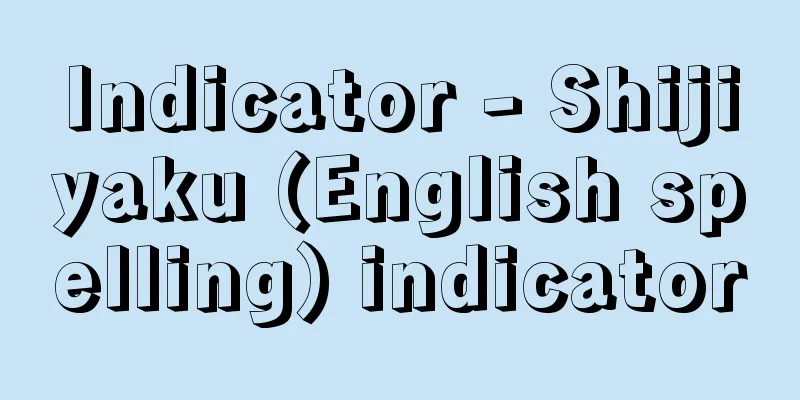Indicator - Shijiyaku (English spelling) indicator

|
A reagent used to determine the equivalence point in a titration. There are two types of titration: one that indicates the endpoint by observing phenomena such as color change, generation or disappearance of fluorescence, chemiluminescence, turbidity, and precipitation directly with the naked eye, and one that indicates the endpoint by a change in physical properties. Color indicators are the most widely used indicators, and there are two types of color indicators: monochromatic indicators, which change from colorless to colored or colored to colorless at the end point, and bichromatic indicators, which change from one color to another at the end point. [Yoshio Narusawa] ClassificationIndicators can be classified according to the type of reaction they indicate as follows: (1) Acid-base indicators These are used as indicators for determining the end point in acid-base titration or neutralization titration, and change color with the change in hydrogen ion concentration in the solution. These types of indicators are organic dyes that are themselves weak acids or bases, and are classified as acid indicators and base indicators. In general, the color of the ion (dissociated indicator anion for acid indicators, protonated ion for base indicators) is different from the color of the undissociated form, and the color change is rapid and reversible. Therefore, the change in hydrogen ion concentration or hydrogen ion exponent (pH) in the solution can be determined. Indicators have different colors before and after each specific pH range (called the color change range), and the color at a pH lower than the color change range is called an acid color, and the color at a pH higher than the color change range is called a basic or alkaline color. Some acid-base indicators have two color change ranges. (2) Redox indicators These are used to indicate the end point of an oxidation-reduction reaction in a solution. They are indicators that are involved in the electron transfer reaction and have significantly different colors between the oxidized and reduced forms. During titration, the indicator changes color as it is rapidly oxidized or reduced by the potential generated by the oxidation-reduction reaction, making it possible to determine the end point. There are fewer types of oxidation-reduction indicators than acid-base indicators, and the potential changes depending on conditions such as the solution composition, so there are often restrictions on the conditions of use. In neutralization titration, the color change of the acid-base indicator is generally rapid and reversible whether an acid is titrated with a base or a base is titrated with an acid, so either method can be used unless there is a special reason, but in oxidation-reduction titration, the titration method is often limited. (3) Metal indicators Also called metal dye indicators or metal color indicators, these are organic dyes that form not very stable chelates with metal ions and are used in chelation titrations. The chelates formed by the reaction of the indicator with the metal ions must show a color different from that of the indicator itself, and must be less stable than the chelates formed between the chelating agent (the titrant) and the metal ion, and must release the metal ion to the chelating agent near the metal ion index (pM) value of the equivalence point. Metal indicators usually have both acid-base properties and act not only as pM indicators but also as pH indicators. Therefore, in order to clearly detect the color of the metal indicator in the solution during titration, the pH value of the solution must be constant. A buffer solution is used to keep the pH value of the solution constant. (4) Precipitation indicators Indicators used in precipitation titration are classified into the following three categories: (a) Formation of colored precipitate (Mohr's method) This method was proposed in 1856 by Karl Friedrich Mohr (1806-1879) of Germany, and is an example of an indicator used in this titration. When chloride ions or bromide ions in a neutral or slightly acidic solution are titrated with silver ions, a chromate salt is added. Once the equivalence point is reached, a reddish-brown precipitate of silver chromate is formed, and this point is regarded as the end point. There are not many examples of indicators that form a colored precipitate different from that produced in precipitation titrations, as in this example. (b) Formation of a colored complex (Volhard method) This method was proposed in 1874 by Jacob Volhard (1834-1910) of Germany. An example of this indicator is iron alum (ammonium iron(III) sulfate NH 4 Fe(SO 4 ) 2・12H 2 O), which is added when titrating silver ions with thiocyanate ions. In this titration, a white precipitate of silver thiocyanate is formed, and after the equivalence point, the excess thiocyanate ions combine with iron(III) ions to form a soluble red complex ion, thiocyanatoferric complex ion, which is designated as the endpoint. The endpoint indication by the formation of this complex ion is sensitive. There are not many examples of the endpoint indication by the formation of a colored complex. (c) Adsorption indicators A color change occurs when the indicator ions are adsorbed to the precipitate. Adsorption indicators are weak acids or bases, so the pH range in which they exist in the dissociated or protonated form in solution varies depending on the indicator. The mechanism by which adsorption indicators work in precipitation titrations is different from the previous two cases. In 1923, American K. Fayance and O. Hassell discovered that fluorescein and its derivatives can be used as indicators in argentometry, and explained this mechanism as follows: When silver nitrate is added to a solution of sodium chloride, the resulting silver chloride precipitate particles adsorb the excess chloride ions in the solution to their surfaces, and the silver chloride colloidal particles become negatively charged. The first adsorption layer thus formed further adsorbs cations in the solution to form a weakly bound second adsorption layer. If silver nitrate is continued to be added until silver ions become in excess, the silver ions replace the chloride ions in the first adsorption layer and are adsorbed, causing the precipitate particles to become positively charged and forming a second adsorption layer that is weakly bound to the anions in the solution. When fluorescein (a weak acid, represented as HFl) is added to this solution, the anion Fl - is not adsorbed to the silver chloride precipitate as long as there is an excess of chloride ions. Fluorescein emits yellow-green fluorescence when there is an excess of chloride ions, but if there is an excess of silver ions just after the endpoint, Fl - is adsorbed to the surface of the positively charged particles. As a result, the precipitate turns pink and the fluorescence disappears, allowing the endpoint to be determined. When titrating chloride ions using silver ions as the titrant, the charge of the precipitate becomes negative at the end point, so a positively charged dye is adsorbed and the precipitate becomes colored. Basic indicators such as methyl violet and rhodamine 6G are used as such indicators. An appropriate adsorption indicator is selected depending on the type of precipitation titration. (5) Fluorescent indicator: An indicator that shows the end point of a titration by the appearance or disappearance of fluorescence. When calcium (Ca) is directly titrated with ethylenediaminetetraacetic acid (EDTA), the pH is adjusted to 12 with potassium hydroxide (KOH) and calcein is added as an indicator, and the green fluorescence disappears at the end point of the titration. The advantage of this titration method is that it can also be applied to colored solutions. Other well-known indicators include fluorescein, umbelliferone, rhodamine B, and eosin. Although they are generally more sensitive than color change indicators, they are easily affected by many factors, so the conditions of their use must be strictly controlled. Usually, only one type of indicator is used, but sometimes two or more are mixed together. In this case, it is called a combination indicator, and there are various types of combination indicators, such as mixed indicators, shielding indicators, and universal indicators. For example, a mixture of methyl red (acid red, color change range pH 4.2-6.3, alkaline yellow) and bromocresol green (acid yellow, color change range pH 3.8-5.4, alkaline blue) in a ratio of 2:3 will clearly change color at pH 5.1, with the acidic color being wine red and the alkaline color being green. The universal indicator is an even more sophisticated combination, and for example, when the appropriate amounts of thymol blue, tropaeoline OO, bromophenol blue, bromocresol green, and bromocresol purple are mixed, the color will change to red, orange, yellow, green, indigo, etc. for every pH unit between pH 1.0 and pH 7.0. [Yoshio Narusawa] "Iwanami Dictionary of Physics and Chemistry, 3rd Edition, Expanded Edition, edited by Tamamushi Fumichi et al. (1981, Iwanami Shoten)" ▽ "Chemistry Encyclopedia, edited by Oki Michinori et al. (1989, Tokyo Kagaku Dojin)" ▽ "Chemical Society of Japan, Chemistry Handbook, Basics, 4th Revised Edition (1993, Maruzen)" ▽ "Quantitative Analysis, edited by the Japan Society for Analytical Chemistry (1994, Asakura Shoten)" [Reference] | | | | | | | | | | | | | | | | |Source: Shogakukan Encyclopedia Nipponica About Encyclopedia Nipponica Information | Legend |
|
滴定において当量点を判定するのに用いる試薬をいう。色の変化、蛍光の生成・消滅、化学発光、濁り、沈殿の生成といった現象を直接肉眼で観察することによって終点を指示するものと、物理的性質の変化によって終点を指示するものがある。 指示薬としてもっとも広く用いられているのは呈色指示薬であるが、呈色指示薬には終点において無色から有色、あるいは有色から無色に変わる一色指示薬(単色指示薬)と、終点においてある色から別の色に変わる二色指示薬がある。 [成澤芳男] 分類指示薬が指示する反応の型により分類すると次のようになる。 (1)酸塩基指示薬 酸塩基滴定あるいは中和滴定における終点判定の指示薬として用いられ、溶液中の水素イオン濃度の変化に伴って変色するもの。この種の指示薬は、それ自身が弱酸または弱塩基の有機色素で、酸性指示薬と塩基性指示薬に分類される。一般にそのイオン(酸性指示薬であれば酸解離した指示薬陰イオン、塩基性指示薬であればプロトン付加型イオン)となったものの色と非解離型のものの色が異なり、変色は速やかで、しかも可逆的である。したがって溶液中の水素イオン濃度あるいは水素イオン指数(pH)の変化を判定することができる。指示薬はこのようにおのおの特定のpH領域(変色域という)を隔てて前後で呈色が異なるが、変色域より低いpHにおける色を酸性色、高いpHにおける色を塩基性色またはアルカリ性色という。酸塩基指示薬には変色域を2個有するものがある。 (2)酸化還元指示薬 溶液中の酸化還元反応の終点指示に用いられるもの。それ自身が電子の授受反応に関与し、酸化体と還元体の色が著しく異なる指示薬をいう。滴定に際し、酸化還元反応で生じる電位によって指示薬が迅速に酸化または還元されて変色するので、終点判定ができる。酸化還元指示薬は酸塩基指示薬に比べて種類も少なく、また電位が溶液組成などの条件で変わるので、使用条件に制限のある場合が多い。中和滴定は一般に、酸を塩基で滴定しても、塩基を酸で滴定しても酸塩基指示薬の変色は迅速かつ可逆的なので、特別な理由がなければ、いずれの方法も用いうるが、酸化還元滴定では滴定の方法は限定される場合が多い。 (3)金属指示薬 金属色素指示薬または金属変色指示薬ともいわれ、それ自身金属イオンとそれほど安定ではないキレートをつくる有機色素で、キレート滴定に用いられる指示薬である。指示薬が金属イオンと反応して生成するキレートは、指示薬自身の色と異なる色を示さなければならないし、また滴定剤であるキレート試薬と金属イオンとの間で生ずるキレートより不安定で、当量点の金属イオン指数(pM)値近傍でキレート試薬に対して金属イオンを放出しなければならない。金属指示薬は酸塩基の性質をも兼ね備えているのが普通であり、pMに対する指示薬として働くのみならず、pH指示薬としても働くので、滴定の際に金属指示薬が溶液中で呈する色をはっきり検知するためには、溶液のpH値を一定にしなければならない。溶液のpH値を一定にするのに緩衝溶液が用いられる。 (4)沈殿指示薬 沈殿滴定に用いられる指示薬で、次の三つに分類される。 (a)有色沈殿の生成(モール法) 1856年ドイツのモールKarl Friedrich Mohr(1806―1879)によって提唱された方法で、中性または微酸性溶液中の塩化物イオンあるいは臭化物イオンを銀イオンで滴定する際に加えるクロム酸塩はこの滴定における指示薬の例である。当量点を過ぎるとクロム酸銀の赤褐色沈殿が生成するので、その点を終点とする。この例のように沈殿滴定で生ずる沈殿と異なる有色沈殿を生成する指示薬の例はあまり多くない。 (b)有色錯体の生成(フォルハルト法) 1874年ドイツのフォルハルトJacob Volhard(1834―1910)により提唱された方法で、銀イオンをチオシアン酸イオンで滴定するとき加える鉄ミョウバン(硫酸鉄(Ⅲ)アンモニウムNH4Fe(SO4)2・12H2O)はこの指示薬の例である。この滴定では白色のチオシアン酸銀の沈殿が生成し、当量点を過ぎると過剰のチオシアン酸イオンは鉄(Ⅲ)イオンと可溶性の赤色錯イオン、チオシアナト鉄(Ⅲ)錯イオンを生成するので、この点を終点とする。この錯イオン生成による終点指示は鋭敏である。有色錯体生成による終点指示の例も多くない。 (c)吸着指示薬 指示薬のイオンが沈殿に吸着するとき変色がおこる。吸着指示薬は弱酸または弱塩基なので、溶液中に解離型あるいはプロトン付加型として存在するpH領域は指示薬によって異なる。吸着指示薬が沈殿滴定において作用する機構は前二者の場合と異なる。1923年アメリカのK・ファヤンスはO・ハッセルとともに、フルオレセインおよびその誘導体が銀滴定の指示薬として用いられることをみいだし、この機構を次のように説明した。塩化ナトリウムの溶液に硝酸銀を加えた場合、生じた塩化銀の沈殿粒子は溶液中に過剰に存在する塩化物イオンをその表面に吸着し、塩化銀のコロイド粒子は負に帯電することになる。このようにして生じた第一吸着層は、さらに溶液中の陽イオンを吸着して弱い結合状態の第二吸着層を形成する。 銀イオンが過剰になるまで硝酸銀を加え続けていくと、銀イオンは第一吸着層の塩化物イオンを置換して吸着するため沈殿粒子は正に帯電し、溶液中の陰イオンと弱く結合した第二吸着層を形成する。 この溶液にフルオレセイン(弱酸なのでHFlと表す)を加えると、陰イオンFl-は塩化物イオンが過剰に存在する限り塩化銀の沈殿に吸着されることはない。フルオレセインは塩化物イオンが過剰に存在していると黄緑色の蛍光を発しているが、終点直後に銀イオンが過剰になるとFl-は正に帯電した粒子の表面に吸着する。その結果沈殿はピンク色を呈し、蛍光は消失し、終点判定ができる。 滴定液として銀イオンを用いて塩化物イオンを滴定する場合、終点で沈殿の電荷は負になるので正電荷の色素が吸着されて沈殿が着色する。このような指示薬としてメチルバイオレット、ローダミン6Gなどの塩基性指示薬が用いられる。沈殿滴定の種類により、適当な吸着指示薬が選択される。 (5)蛍光指示薬 蛍光の発生または消失で滴定の終点を示す指示薬をいう。カルシウムCaをエチレンジアミン四酢酸(EDTA)で直接滴定する場合、水酸化カリウムKOHにてpH12に調整し、カルセインを指示薬として加えると、滴定終点で緑色の蛍光が消失する。この滴定法の利点は着色溶液にも適用できることである。このほかにフルオレセイン、ウンベリフェロン、ローダミンB、エオシンなどが知られている。 一般に変色指示薬より鋭敏であるが、多くの因子に影響を受けやすいので、使用条件を厳密にする必要がある。 指示薬は普通1種類のものを使うが、まれには二つ以上を混ぜて使う場合もある。このような場合を配合指示薬といい、配合指示薬には混合指示薬、遮蔽(しゃへい)指示薬(マスク指示薬)、万能指示薬などがある。混合指示薬の例としては、メチルレッド(酸性色赤、変色域pH4.2~6.3、アルカリ性色黄)とブロモクレゾールグリーン(酸性色黄、変色域pH3.8~5.4、アルカリ性色青)を2対3の割合で混合したものは、pH5.1で鮮明に変色し、酸性色はぶどう酒赤、アルカリ性色は緑色となる。また、万能指示薬はさらにうまく組み合わせたもので、たとえばチモールブルー、トロペオリンOO、ブロモフェノールブルー、ブロモクレゾールグリーン、ブロモクレゾールパープルの適当量を混合した場合には、pH1.0からpH7.0までの間で、1pH単位ごとに赤、橙(だいだい)、黄、緑、藍(あい)などの色に変化する。 [成澤芳男] 『玉虫文一他編『岩波理化学辞典』第3版増補版(1981・岩波書店)』▽『大木道則他編『化学大辞典』(1989・東京化学同人)』▽『日本化学会編『化学便覧 基礎編』改訂4版(1993・丸善)』▽『日本分析化学会編『定量分析』(1994・朝倉書店)』 [参照項目] | | | | | | | | | | | | | | | | |出典 小学館 日本大百科全書(ニッポニカ)日本大百科全書(ニッポニカ)について 情報 | 凡例 |
Recommend
Stolen Bucket - Stolen Bucket
…In his “Miscellany” (1608), the main theme is re...
Cost of the performance - Yogekiryo
One of the salaries paid to Ritsuryo government of...
Ephippianthus sawadanus (F.Maek.) Ohwi
A small terrestrial orchid found rarely on the for...
Inuyama Headworks
…Recently, it has become difficult to take water ...
pous
...There are two types of notation: instrumental ...
Dipylon of Athens - Dipylon of Athens
…The gates of the fortresses built in the upper r...
Siniperca
…A general term for freshwater fish belonging to ...
Grand Trianon (English spelling)
…The king's apartments were positioned as the...
sclerotin
…The inner protocuticle makes up the majority of ...
Astilbe - Astilbe
A winter-hardy perennial or shrub in the Saxifrag...
Hallyeosuido - Hallyeosuido
A waterway that runs from Hansan Island in the sou...
Kakurai Sand Mound
1805-1855 A Confucian scholar in the late Edo per...
Paria Peninsula - Paria Peninsula (English spelling)
A peninsula in the state of Sucre in northeastern ...
Challenging student - Ayanosho
...The origin of this group was a group of crafts...
Ol'ga Fyodorovna Berggol'ts (English spelling)
A Russian female poet. Graduated from the Faculty...
![Pitcairn [island] - Pitcairn](/upload/images/67cc9f2cc8638.webp)



![Aji [town] - Aji](/upload/images/67cad32dac8bd.webp)




